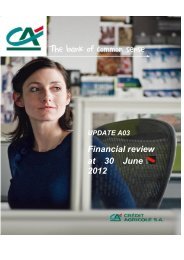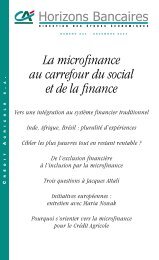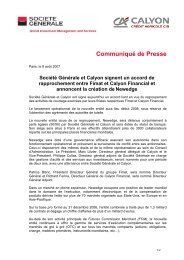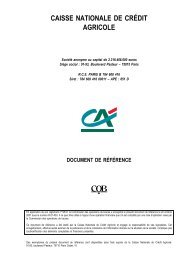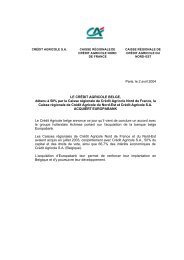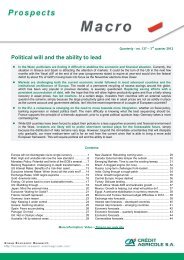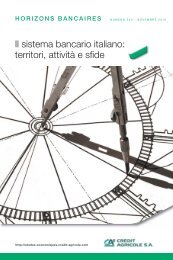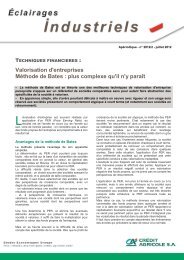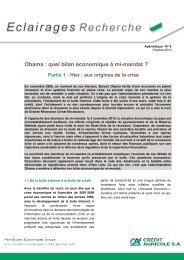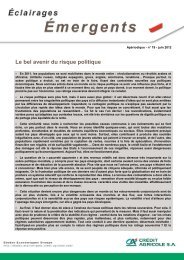PDF (2.47 Mo) - Le Crédit Agricole
PDF (2.47 Mo) - Le Crédit Agricole
PDF (2.47 Mo) - Le Crédit Agricole
- No tags were found...
You also want an ePaper? Increase the reach of your titles
YUMPU automatically turns print PDFs into web optimized ePapers that Google loves.
21 RAPPEL_T1CORPORATE GOVERNANCE AND INTERNAL CONTROLChairman’s r eport on c orporate g overnance and i nternal c ontrol presentedto the Annual General Meeting of s hareholders on 21 May 2008• authority is delegated from the Group RCPR to the BusinessLine RCPRs, which report up the line to Group RCPR in carryingout their duties; these officers are also subject to disclosure andearly warning obligations vis-à-vis the Group Risk ManagementDepartment;• a Business Line <strong>Mo</strong>nitoring Committee periodically bringstogether the DRG and the entity to review the quality of therisk management and permanent control system, including incorporate and investment banking (Calyon).Regional BanksBanking regulations on risks apply to each Regional Bankindividually. Each Regional Bank has a Risk Management andPermanent Controls Officer, who reports to his Chief ExecutiveOfficer and is in charge of risk management oversight andcompliance of his entity’s permanent control system.As the central body for the Regional Banks, Crédit <strong>Agricole</strong> S. A.consolidates the risks borne by the Regional Banks and managestheir Risk Management and Permanent Controls function via theGroup Risk Management and Permanent Controls Departmentby circulating the appropriate procedures to the Regional Banks,particularly for implementing the Group permanent control system.Furthermore, large credit exposures borne by the RegionalBanks must be presented to Foncaris, a credit institution that isa 100%-owned subsidiary of Crédit <strong>Agricole</strong> S. A., which partiallyguarantees such exposures. The requirement that the RegionalBanks must ask Foncaris to guarantee their main transactions givesthe central body an effective tool for assessing the associated riskbefore accepting it.INTERNAL CONTROL SYSTEM FOR INFORMATIONSYSTEMS SECURITY AND BUSINESS CONTINUITY PLANSThe Group Risk Management and Permanent Controls Divisionhas set up organisations at Group level, inter alia in the areasof governance and security organisation, giving Crédit <strong>Agricole</strong>unified, consistent oversight across its entire scope and thewherewithal to standardise its systems.All Group entities (the subsidiaries and Regional Banks) haveimplemented the system, which entails appointing a person incharge of IT systems security (RSSI), a person in charge of thebusiness continuity plan (RPCA) and setting up crisis units atseveral levels (entity, community, by business line and nationally).The RPCA and RSSI are responsible for setting up user backupplans and for ensuring they are operational through gradualdeployment of business continuity plans exercises, and forensuring IT systems security, primarily in the area of intrusiondetection, in compliance with Group regulations and standards.The Group permanent control system, which was reinforced atthe beginning of 2007, provides for a minimum base of mandatorycontrols for all entities in business continuity plans and IT systemssecurity, with results reported to the Group Risk Management andPermanent Controls Division.Internal control system for accountingand financial informationROLES AND RESPONSIBILITIES FOR PREPARATIONAND PROCESSING OF FINANCIAL INFORMATIONIn keeping with the applicable rules within the Group, theorganisational principles and responsibilities of the Group FinanceDepartment functions are set out in a procedure.The Central Finance Function is organised as a business line withinthe Crédit <strong>Agricole</strong> S. A. Group. The heads of the finance functionfor a business line or subsidiary report up the line to the head of thebusiness line or subsidiary and to the Group Finance Director.At each business line, the Finance Department acts as a relay forcirculating the Group’s principles with respect to standards andinformation system organisation, as a function of each businessline’s special attributes; in some cases, it also constitutes anintermediate level for preparation of the business line’s accountingand business management information.Each business line and/or entity must have the resources to ensurethat accounting and management information transmitted to theGroup for consolidation purposes is reliable. It must ensure thatdata conform to Group accounting standards and are consistentwith the individual accounts approved by its decision-makingbody, and it is responsible for reconciliation of accounting andmanagement data.Within the Group Finance Department, three functions are primarilyresponsible for preparation of published accounting and financialinformation: Accounting, Management Control and FinancialCommunication .ACCOUNTINGThe main purpose of the Accounting function is to draw up theparent company accounts of Crédit <strong>Agricole</strong> S. A., the consolidatedaccounts of the Crédit <strong>Agricole</strong> S. A. and Crédit <strong>Agricole</strong> Groups,and segment reporting for the Crédit <strong>Agricole</strong> S. A. Group based onthe Financial Communication function’s definition of the businesslines. In accordance with applicable regulations, the Accountingfunction defines and circulates the accounting standards andprinciples that apply to the Group. It oversees accountingstandards, lays down the rules governing the architecture of theaccounting information and regulatory reporting system, andmanages the accounting processes for account consolidation andregulatory reporting.30 I Crédit <strong>Agricole</strong> S.A. I Registration d ocument 2007



